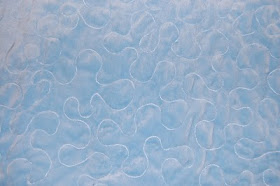Ah, I love red. This backing fabric (white dot on red, right) for Andrea's feedsack quilt is Mama's Feedsacks line by Darlene Zimmerman for Robert Kaufman fabrics. It is the perfect match to the 1930's red feedsack pieces in this quilt. What's even better is finding the exact matching thread (100% cotton, 50/3, #279 red) by Presencia (
http://www.presenciausa.com/). I only had the small spool to fill a couple of bobbins but it's available in a 125 gram cone, just delivered to my doorstep by UPS. So I'm off and running.

For the top thread, I'm using Presencia's winter white #206. I like to use an off white rather than pure white for most vintage style quilting. I'm using a walking foot to stitch in the ditch to secure all the seams. Here's how I go about balancing the tension so the red doesn't show up on top and the white doesn't pull to the back.
Last time I was sewing something, I had polyester thread in the bobbin which requires a tighter bobbin tension--polyester thread is smooth and slick so if the tension is too loose, lots of loops will show underneath. When switching to the cotton thread I'm using now, I had to loosen the bobbin thread and also adjust the top thread tension. I go through a series of different settings and mark my test fabric with a pencil to see which # is the one to go with. Here, I had the best results with a top thread tension of 2.

To avoid getting small tucks in the backing fabric, I use a straight pin to secure the intersections which stitching-in-the-ditch. This is very effective is keeping the backing fabric from bunching up. I keep a couple of pins in the square I'm quilting and keep moving them down as I go. The safety pins are for basting the quilt layers and I keep them in until all the stitching-in-the-ditch is completed. Additional quilting can be done without safety pins because they have done their job and the quilt will be light, yet secure, to handle.
 Copyright ©2010, Sharon Baggs
Copyright ©2010, Sharon Baggs

 For the thread, I chose Presencia's 50 wt. cotton (color #300--medium bay blue). When you free motion on minkie, the thread 'melts' into the fabric, making it difficult to see the actual stitch. When your machine is stopped, with the needle down into the fabric, use your fingers to feel the area you are heading into so you don't cross over stitched lines. Sufficient lighting helps to see where you've been and where you're going. (View of back, shown below)
For the thread, I chose Presencia's 50 wt. cotton (color #300--medium bay blue). When you free motion on minkie, the thread 'melts' into the fabric, making it difficult to see the actual stitch. When your machine is stopped, with the needle down into the fabric, use your fingers to feel the area you are heading into so you don't cross over stitched lines. Sufficient lighting helps to see where you've been and where you're going. (View of back, shown below)




 My attempt to remove them resulted in only lightening the x's and dots. I did this by mixing a solution of baking soda, a few drops of Synthrapol (which contains Isopropyl Rubbing Alcohol) so I added a couple more drops of rubbing alcohol to the solution and gently scrubbed it in with a toothbrush. Then I let the quilt soak in lukewarm water for 1-2 hrs., spun out the water and rinsed. I avoided heavy agitation of the wash cycle. I also read the suggestion to use Oxo Brite non-chlorine bleach. I tested this on a small area of the quilt and it didn't seem to lighten the dye. However, if left to soak for a time, it might be effective.
My attempt to remove them resulted in only lightening the x's and dots. I did this by mixing a solution of baking soda, a few drops of Synthrapol (which contains Isopropyl Rubbing Alcohol) so I added a couple more drops of rubbing alcohol to the solution and gently scrubbed it in with a toothbrush. Then I let the quilt soak in lukewarm water for 1-2 hrs., spun out the water and rinsed. I avoided heavy agitation of the wash cycle. I also read the suggestion to use Oxo Brite non-chlorine bleach. I tested this on a small area of the quilt and it didn't seem to lighten the dye. However, if left to soak for a time, it might be effective.